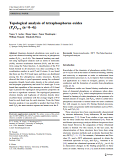Topological analysis of tetraphosphorus oxides (P4O6+n (n = 0–4))
Compartir este ítem
Fecha
2013Autor
Acelas, Nancy Y.
López, Diana
Mondragón, Fanor
Tiznado, William
Flórez, Elizabeth
Acelas, Nancy Y.; Universidad de Antioquia
López, Diana; Universidad de Antioquia
Mondragón, Fanor; Universidad de Antioquia
Tiznado, William; Universidad Andres Bello
Flórez, Elizabeth; Universidad de Medellín
Citación
Metadatos
Mostrar el registro completo del ítemResumen
Quantum chemical calculations were used to analyze the chemical bonding and the reactivity of phosphorus oxides (P4O6+n (n = 0–4)). The chemical bonding was studied using topological analysis such as atoms in molecules (AIM), electron localization function (ELF), and the reactivity using the Fukui function. A classification of the P-O bonds formed in all structures was done according to the coordination number in each P and O atoms. It was found that there are five P-O bond types and these are distributed among the five phosphorus oxides structures. Results showed that there is good agreement among the evaluated properties (length, bond order, density at the critical point, and disynaptic population) and each P-O bond type. It was found that regardless of the structure in which a P-O bond type is present the topological and geometric properties do not have a significant variation. The topological parameters electron density and Laplacian of electron density show excellent linear correlation with the average length of P-O bond in each bond type for each structure. From the Fukui function analysis it was possible to predict that from P4O6 until P4O8 the most reactive regions are basins over the P.
Colecciones
- General [206]

